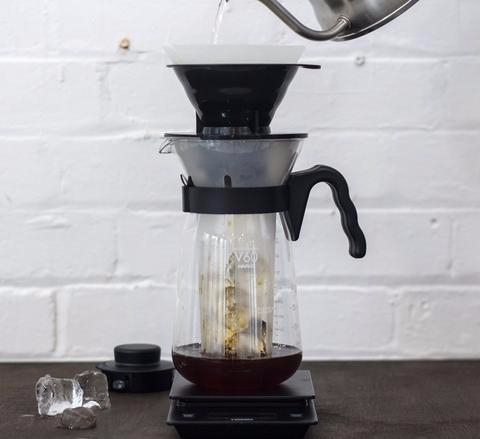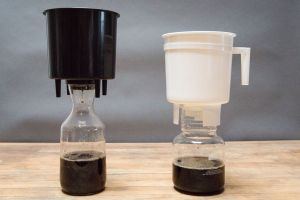Our Blog

Cold Brew vs Iced Pour Over

By: Gabe Venegas
Wholesale Account Manager and Coffee Educator, Kean Coffee
With summer rapidly approaching, we thought It would be fun to bring up the never-ending battle between Cold Brew vs Iced Pour Over. For this article, we’re not going to tell you which one is better than the other because, at the end of the day, coffee is all about flavor preference. Our main objective is to point you in the right direction depending on how you would like to enjoy your coffee and highlight what each brew method brings to the table… literally!
Cold Brew
 The increasingly popular cold brew has been popping up everywhere from grocery stores, vending machines, and even gas stations. So, what’s all the hype? Why are people flocking to this beverage? To answer these questions, let us dive into what cold brew and how it works.
The increasingly popular cold brew has been popping up everywhere from grocery stores, vending machines, and even gas stations. So, what’s all the hype? Why are people flocking to this beverage? To answer these questions, let us dive into what cold brew and how it works.
Cold brew is made using coarse ground coffee and adding either cold or room temperature water and steeping between 12 to 24 hours or using a slow drip process. Cold Brewing devices include the Toddy brewer, Filtron, the Kyoto Drip Tower, Yama Drip Tower, a French Press, or a mason jar (see our retail shelves at Kean Coffee to purchase some of these devices for home use). Unlike regular coffee, cold brew uses time rather than heat for extraction. The result is a very smooth and rich beverage with a heavier mouthfeel, syrupy flavor notes, and low acidity. Because cold brew steeps in water for an extended period of time, it makes it the easiest of all brewing methods and requires no technical skills. If you have fresh coarse ground coffee, good quality water (either bottled, filtered, or reverse osmosis), and a vessel, you can make an amazing cold brew. Additionally, cold brew can last up to two weeks when refrigerated, it can yield many cups, great for gatherings or parties, and it can be easily adjusted to strengthen to preference.
Due to its unique flavor characteristics, cold brew coffee can be used in a variety of ways and has the adaptability to serve many functions. As a concentrate, it can be used as a base for blended drinks. It also can be used to make coffee cocktails, and it can be zapped in the microwave to make it a hot coffee without the bright acidity for those who want a rich and syrupy cup. Lastly, if adding cream and sugar to your coffee is your thing, then cold brew is the way to go. Due to its process of mellowing out the acidity and highlighting the body and sweetness, cold brew is perfect for mixing with dairy as they complement one another.
Iced Pour Over (AKA Japanese Iced Method or Flash Brew)

Now let’s talk about what an Iced Pour Over is and how it differs from cold brew. What’s the difference between the two and why choose one over the other? Like we mentioned earlier, flavor preference is a deciding factor to choosing one over the other. However, there are other variables involved that can help you choose what’s best for you.
Iced Pour Overs take only a few minutes to brew and have a brighter flavor than you’d expect from a summer coffee drink. It can be made with several types of manual brewers such as a Chemex, Hario V60 Fretta, or AeroPress (see our coffeehouse retail selection to purchase these brewers). Instead of using only hot water, half the water is already in the pot in the form of ice. This method has the advantages that come with hot brewing, but is instantly chilled as the coffee drips onto the ice, thus giving it its explosion of aromatics in the cup. An Iced Pour Over tends to be fruitier, sweet, crisp, delicate, and not heavy. It is best to enjoy immediately after brewing since it does not last due to the ice cubes. Once the ice melts, your brew will be diluted. This is a great method of brewing if you want something fast and only for yourself or two people. In addition, an Iced Pour Over does not go well with milk since it is a brighter cup with more acidity and less body; adding dairy can overpower the coffee or even make it taste sour.
Opposite of the simple cold brew method, an Iced Pour Over is much more complex and requires a bit more technique. If you can bear with us for a bit, we’d like to touch a little on how this happens. To fully understand Iced Pour Overs, you need to understand solubility, volatility, and oxidation. Let’s talk science!
Solubility
Solubility, in our case, is coffee’s ability to dissolve in water. Coffee grounds release soluble solids or particles that give taste and aromatics of the coffee, thus creating what we know as brewed coffee. Generally, particles are more soluble at higher temperatures and less soluble at lower temperatures. When we brew coffee, we use hot water between 195 to 205 degrees Fahrenheit to dissolve the coffee solids out of the coffee grounds and into the water. When using cold water, coffee will dissolve slowly and incompletely; many of the soluble substances in coffee won’t make it out of the grounds and into the water.
Volatility
Volatility is the ability of substances to vaporize. Volatile activity also increases with temperature: that’s why hot coffee is so aromatic. Problem is, when you’re smelling coffee, it’s losing its aromatics to the air. When brewing coffee hot and then cooled quickly, the volatility of coffee escapes into the air caused by the hot water, but is instead of being lost for good, it is recaptured by the ice cubes when it begins to cool.
Oxidation
Oxidation leads to rancidity. When oxygen messes with oils, it makes them turn rancid, causing them to taste bad. For example, the taste of an unclean coffee urn is caused by oxidized coffee oils. Coffee kept warm takes on these same flavors, since oxidation happens much more quickly at high temperatures. This is another reason why cooling coffee quickly after brewing is essential.
In a nut shell, Iced Pour Overs work in the following manner: To fully extract flavor, it is brewed hot. To lock in aromatics and prevent off-flavors, it is cooled instantly.
Now that we have covered both brewing methods, here’s a breakdown of a pros and cons list to help you decide once and for all what method you might prefer:
Cold Brew |
Iced Pour Overs |
||
| Pros | Cons | Pros | Cons |
| Anyone can do it | Takes a long time to make | Takes only a few minutes | Requires technique (not to worry, we’ll gladly teach you) |
| Serves more than 1 person | Brews only in large quantities (you can’t brew for a single person, but you can serve yourself one cup) | Serves only 1-2 people (if you don’t want to share) | Serves only 1-2 people (if you want to serve more people) |
| Lasts for up to 2 weeks | Enjoy immediately | Can’t store for later | |
| Goes well with or without milk | Does not go well with milk (for people who prefer black coffee) | ||
| Requires little brewing equipment (less expensive) | Requires more brewing equipment (for the brewing gear junkies) | More expensive | |
Tasting Notes |
Tasting Notes |
||
| · Low acidity (not bright) | · Highlights acidity (tends to be brighter) | ||
| · Smooth and rich body | · Crisp and lighter body | ||
| · Heavier mouthfeel | · Lighter mouthfeel | ||
| · Simple and straightforward | · Delicate and complex | ||
We hope you have been intrigued by our coffee comparisons and we wish you an awesome caffeinated summer time! Please feel free to share your personal opinions and preferences for Cold Brew vs. Iced Pour Over in the comments 🙂
